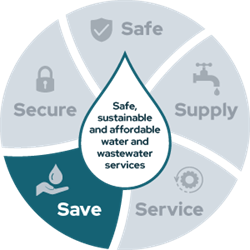Water saving for business
It's important to know how much water your business is using - and saving water means your business is saving money.
Make sure your staff know that saving water is a priority.
- Include water conservation policies and procedures in staff training.
- Involve staff by providing staff incentives and link water conservation to performance reviews.
- Use staff noticeboards, newsletters and emails to share water saving tips. Set water use targets and publish progress updates.
- Appoint a ‘water champion’ to keep your business focused on saving water.
Free water audits for businesses
Council will visit and assess your business to identify ways to save water. To arrange a free water audit, contact us
Carry out your own water audit
An audit will identify your business water use and costs.
- Check your water bills for the past 2 years to see how much water was used, sudden or gradual increases may indicate a leak.
- Identify the water intensive areas of your business and ways to save water.
- Check for leaks - is the water meter dial moving when no water is being used?
Develop a water conservation plan
- Make sure resources and business commitment are in place to develop a water conservation plan.
- Appoint a ‘water manager’ to action the plan and lead the project.
- Conduct a water audit.
Leaks
- Check for leaks in taps, pipes and hoses.
- Replace washers as soon as they begin to leak.
- Encourage staff and guests to report leaking taps, toilets and fittings.
Cleaning
- Use a bucket for cleaning instead of a tap or hose.
- Use a broom to clean paths and gutters rather than a hose.
- High pressure hoses are water efficient and more effective cleaners than standard hoses.
Commercial kitchens
- A commercial sink uses about 40 litres to fill, while a water efficient dishwasher may use as little as 15 litres.
- Install water efficient appliances (glass and dishwashers, ice makers, coolers and cleaning equipment).
- When buying new appliances, consider those that offer cycle and load size adjustments.
- Make sure glass and dishwashers are full before using.
- Rinse dishes in a plugged sink or bowl rather than under a running tap.
Construction industry
- Retain as much vegetation as possible during construction to reduce evaporation.
- Install water efficient irrigation systems.
- Use buckets of water for cleaning instead of running water.
- Incorporate water saving principles into all aspects of the project. Prepare a water plan that includes efficient appliances and plumbing, water reuse, landscaping and rainwater collection.
- Stay up to-date with the latest water conservation designs and appliances.
Gardens and nurseries
- Be sure your irrigation system is only watering intended areas, not flowing onto footpaths and roads.
- Check your irrigation system regularly for leaks and broken sprinkler heads and adjust pressures to specification.
- Subirrigation or drip irrigation systems can produce water savings of up to 75% compared to overhead sprinklers. If you do have overhead sprinklers, fix water efficient nozzles.
- Set up wind breaks to cut down on water loss due to evaporation.
- Ensure nursery irrigation systems meet the standard recommended by the Nursery Industry Association of Australia.
- Choose an irrigation system which allows automatic shutdown, moisture sensors, and can apply water at different rates.
- Look for ways to recycle water - for example, rooftops and runoff are a good source of irrigation water.
Find more ways to save water outdoors
Laundromats and accommodation providers
- Commercial laundries, hotels and aged care facilities use large volumes of water with potential for significant water and cost savings.
- Older commercial washing machines use a lot more water than new machines. Initial replacement costs may be higher, but significant water and cost savings will be made over the life of the machine.
- Install a system to divert waste water for irrigation.
- Ensure boilers, pumps, chillers and water heaters are used properly, shut down when not in use, and maintained to prevent leaks, steam or condensation.
- Create a system where guests can choose to keep their towels and bed linen more than one night, reducing the amount of laundry.
- Use a linen service that uses water recycling and sustainable business practices.
